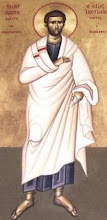 Most converts I speak to come from a background of faith (more often than not it is Anglican) whereas I do not.
Most converts I speak to come from a background of faith (more often than not it is Anglican) whereas I do not.Before finding my faith if I was asked what religion I was I would probably have answered Christian out of instinct or habit however, if you had questioned me further you would probably have found that in truth I was actually agnostic or indeed atheist.
As I have discovered my faith I have found that this background has given me a rather unique outlook. At times it can be a very innocent outlook and then there are others times when I think it is own fair to say it is ignorant.
Which brings me nicely onto the topic of this post. Nearly all Masses (both new order and tradition latin) I attend are said Ad Orientem (facing the east), in my innocence before my introduction to the Catholic blogosphere I knew nothing of the debt concerning facing the people and facing the east in my innocence I only knew and had concluded the following:
(Keeping it simple) Christ was considered by Christians as the light of the world and in the northern hemisphere the sun (the light) rises in the east, consequently it has been tradition to face east when praying.
Although I will admit I was (and remain) slightly curiosity about what the priest was actually doing, I really liked the symbolism and actually preferred it that way. After all I was going to church to pray to God and it made perfect sense to me to symbolically face him when addressing him in prayer.
One point which is often raised when the priests orientation during Mass is debated is that by turning towards the east and therefore away from the congregation, the priest and servers are praying on the congregation's behalf rather than with them, this never once occurred to me, in actual fact because I was always in my pew before the beginning of Mass I actually considered them to be joining me in prayer because I was there first (lol).
One thing I also discovered when the Mass is said Ad Orientem is that you can better appreciate the beauty and ornateness of the priest’s vestments either because there is no altar table in the way or in the case of older vestment designs they were made to wear when the priest is saying the Mass Ad Orientem and are purposely decorated that way. Below I have included a slide show of some particularly beautiful vestments.
As pictures are usually inappropriate for this type of clothing they often adorn symbols such as
IHS, This Emblem is a Monogram which represents the Holy Name of Jesus consisting of the three letters: IHS. During the Middle Ages, the Name of Jesus was written: IHESUS. The monogram, or emblem, IHS contains the first and last letter of the Holy Name. The letters IHS referring to this monogram do not contain periods, or full stops, after each letter as it is an abbreviation of the name IHESUS.
INRI which represents an acronym of the Latin phrase IESVS·NAZARENVS·REX·IVDAEORVM, which translates to English as: "Jesus the Nazarene, King of the Jews", the inscription that Pontius Pilate ordered placed on Jesus' cross
The colours most commonly seen are:
Green, the symbol of nature and a symbol of hope. It is used after Epiphany and after Pentecost.
Purple, the symbol of penitence and mourning. It is use for the seasons of Lent and Advent.
White, the symbol of innocence and triumph. It is used on all feasts of the joyful and glorious mysteries of our Lord’s life (e.g. Christmas and Easter), on the feasts of our Blessed Mother, on the feasts of angels and of all saints who were not martyrs.
Red the colour of blood, which is used on all feasts of our Lord’s Cross and Passion, on the feasts of the Apostles and of all martyrs. Red is also used on Pentecost and in Masses of the Holy Spirit, in memory of the tongues of fire of the First Pentecost.
And perhaps less commonly
Black, which symbolizes death. It is used for the service of Good Friday and for Masses of the Faithful Departed.
Rose, which is permitted in place of purple, on the third Sunday of Advent and the forth Sunday of lent, when the Church tempers the sadness of the penitential seasons with an invitation to rejoice in the Goodness of God our Saviour.
Blue the symbol of heavenly grace. Which I have also seen used on the Feast days of our Blessed Mother.
Acknowledgements to Matthew Doyle for the top photograph.







2 comments:
I'm so glad to hear that you've discovered the beauty of priest and people facing the Father together! I wish people wouldn't write this posture off so readily, but that's where we are currently. Keep sharing!
Yes, please e-mail follow-up comments to me!
Post a Comment